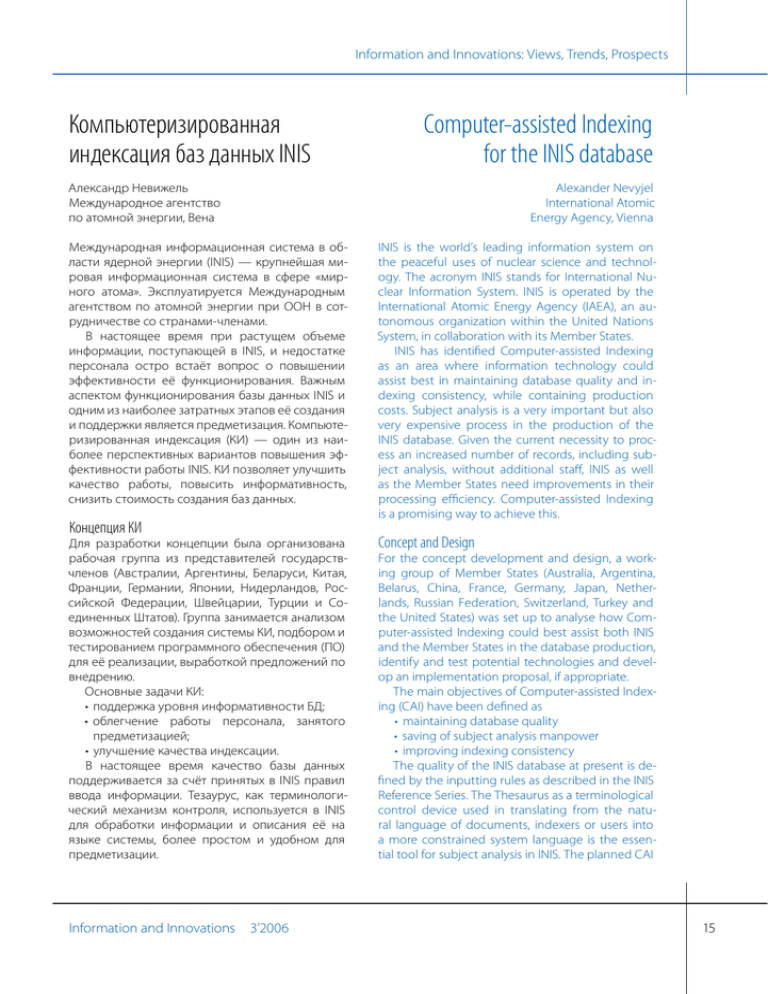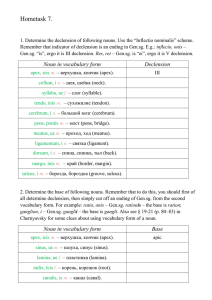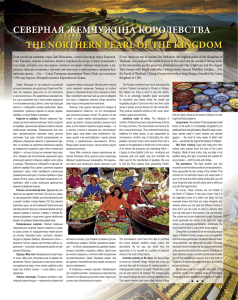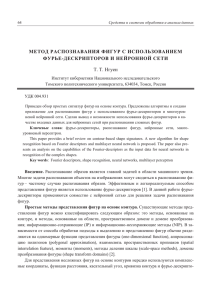Компьютеризированная индексация баз данных INIS Computer
реклама

Information and Innovations: Views, Trends, Prospects Компьютеризированная индексация баз данных INIS Computer-assisted Indexing for the INIS database Александр Невижель Международное агентство по атомной энергии, Вена Ме­ж­ду­на­род­ная ин­фор­ма­ци­он­ная сис­те­ма в об­ лас­ти ядер­ной энер­гии (INIS) — круп­ней­шая ми­ ро­вая ин­фор­ма­ци­он­ная сис­те­ма в сфе­ре «мир­ но­го ато­ма». Экс­плуа­ти­ру­ет­ся Ме­ж­ду­на­род­ным агент­ст­вом по атом­ной энер­гии при ООН в со­т­ руд­ни­че­ст­ве со стра­на­ми-чле­на­ми. В на­стоя­щее вре­мя при рас­ту­щем объ­е­ме ин­фор­ма­ции, по­сту­паю­щей в INIS, и не­дос­тат­ке пер­со­на­ла ост­ро вста­ёт во­прос о по­вы­ше­нии эф­фек­тив­но­сти её функ­цио­ни­ро­ва­ния. Важ­ным ас­пек­том функ­цио­ни­ро­ва­ния ба­зы дан­ных INIS и од­ним из наи­бо­лее за­трат­ных эта­пов её соз­да­ния и под­держ­ки яв­ля­ет­ся пред­ме­ти­за­ция. Ком­пь­ю­те­ ри­зи­ро­ван­ная ин­дек­са­ция (КИ) — один из наи­ бо­лее пер­спек­тив­ных ва­ри­ан­тов по­вы­ше­ния эф­ фек­тив­но­сти ра­бо­ты INIS. КИ по­зво­ля­ет улуч­шить ка­че­ст­во ра­бо­ты, по­вы­сить ин­фор­ма­тив­ность, сни­зить стои­мость соз­да­ния баз дан­ных. Кон­цеп­ция КИ Для раз­ра­бот­ки кон­цеп­ции бы­ла ор­га­ни­зо­ва­на ра­бо­чая груп­па из пред­ста­ви­те­лей го­су­дарствчле­нов (Ав­ст­ра­лии, Ар­ген­ти­ны, Бе­ла­ру­си, Ки­тая, Фран­ции, Гер­ма­нии, Япо­нии, Ни­дер­лан­дов, Рос­ сий­ской Фе­де­ра­ции, Швей­ца­рии, Тур­ции и Со­ еди­нен­ных Шта­тов). Груп­па за­ни­ма­ет­ся ана­ли­зом воз­мож­но­стей соз­да­ния сис­те­мы КИ, под­бо­ром и тес­ти­ро­ва­ни­ем про­грамм­но­го обес­пе­че­ния (ПО) для её реа­ли­за­ции, вы­ра­бот­кой пред­ло­же­ний по вне­дре­нию. Ос­нов­ные за­да­чи КИ: • под­держ­ка уров­ня ин­фор­ма­тив­но­сти БД; • об­лег­че­ние ра­бо­ты пер­со­на­ла, за­ня­то­го пред­ме­ти­за­ци­ей; • улуч­ше­ние ка­че­ст­ва ин­дек­са­ции. В на­стоя­щее вре­мя ка­че­ст­во ба­зы дан­ных под­дер­жи­ва­ет­ся за счёт при­ня­тых в INIS пра­вил вво­да ин­фор­ма­ции. Те­зау­рус, как тер­ми­но­ло­ги­ че­ский ме­ха­низм кон­тро­ля, ис­поль­зу­ет­ся в INIS для об­ра­бот­ки ин­фор­ма­ции и опи­са­ния её на язы­ке сис­те­мы, бо­лее про­стом и удоб­ном для пред­ме­ти­за­ции. Information and Innovations 3’2006 Alexander Nevyjel International Atomic Energy Agency, Vienna INIS is the world’s leading information system on the peaceful uses of nuclear science and technol­ ogy. The acronym INIS stands for International Nu­ clear Information System. INIS is operated by the International Atomic Energy Agency (IAEA), an au­ tonomous organization within the United Nations System, in collaboration with its Member States. INIS has identified Computer-assisted Indexing as an area where information technology could assist best in maintaining database quality and in­ dexing consistency, while containing production costs. Subject analysis is a very important but also very expensive process in the production of the INIS database. Given the current necessity to proc­ ess an increased number of records, including sub­ ject analysis, without additional staff, INIS as well as the Member States need improvements in their processing efficiency. Computer-assisted Indexing is a promising way to achieve this. Concept and Design For the concept development and design, a work­ ing group of Member States (Australia, Argentina, Belarus, China, France, Germany, Japan, Nether­ lands, Russian Federation, Switzerland, Turkey and the United States) was set up to analyse how Com­ puter-assisted Indexing could best assist both INIS and the Member States in the database production, identify and test potential technologies and devel­ op an implementation proposal, if appropriate. The main objectives of Computer-assisted Index­ ing (CAI) have been defined as • maintaining database quality • saving of subject analysis manpower • improving indexing consistency The quality of the INIS database at present is de­ fined by the inputting rules as described in the INIS Reference Series. The Thesaurus as a terminological control device used in translating from the natu­ ral language of documents, indexers or users into a more constrained system language is the essen­ tial tool for subject analysis in INIS. The planned CAI 15 Информация и инновации: оценки, тенденции, перспективы Биб­лио­гра­фи­че­ские за­пи­си (вклю­чая на­зва­ ние и крат­кое опи­са­ние, воз­мож­ную клас­си­фи­ ка­цию и ссыл­ку на пол­ный текст) ана­ли­зи­ру­ют­ся сис­те­мой КИ и фор­ми­ру­ет­ся пе­ре­чень пред­ла­гае­ мых КИ де­ск­рип­то­ров (клю­че­вых слов). При вы­во­ де поль­зо­ва­те­лю (че­рез гра­фи­че­ский ин­тер­фейс) system should meet the present rules for indexing quality and even improve the consistency of the subject analysis. The bibliographic records (including title and abstract, potentially also classification and/or link to full text) should be analyzed by the CAI system, resulting in a list of suggested descrip­ tors. Within the working platform (graphi­ cal user interface) of the CAI system the suggested descriptors should be sorted by their relevance for the content of the document. The CAI system should allow the subject specialist to accept or reject descriptors from the suggested list and to assign additional descriptors when necessary. Functionality Concept пред­ло­жен­ные де­ск­рип­то­ры сор­ти­ру­ют­ся по ре­ ле­вант­но­сти со­дер­жа­нию до­ку­мен­та. Сис­те­ма по­ зво­ля­ет поль­зо­ва­те­лю уда­лять де­ск­рип­то­ры из пред­ло­жен­но­го спи­ска и за­да­вать до­пол­ни­тель­ ные, ко­гда это тре­бу­ет­ся. Функ­цио­ни­ро­ва­ние сис­те­мы КИ Ра­бо­та КИ ос­но­вы­ва­ет­ся на элек­трон­ных биб­лио­ гра­фи­че­ских за­пи­сях, по­лу­чае­мых на­пря­мую от из­да­те­лей или в ре­зуль­та­те ка­та­ло­ги­за­ции из­дан­ ных ра­бот. За­пи­си хра­нят­ся в спе­ци­аль­ном фор­ ма­те INIS (ос­но­ван­ном на XML); пре­ду­смот­ре­но ПО для пре­об­ра­зо­ва­ния в дан­ный фор­мат. Под­ле­жа­щие ана­ли­зу за­пи­си долж­ны со­дер­ жать на­зва­ние и крат­кое опи­са­ние. До­пол­ни­ тель­ные по­ля, та­кие как на­зва­ние жур­на­ла / кон­ фе­рен­ции, мож­но ис­поль­зо­вать для то­го, что­бы 16 The CAI system will work on electronic bibliographic records, which are collected from publishers or produced by the de­ scriptive cataloguing process. The records are in the INIS format (XML); data format conversion facilities have to be provided. The records to be analyzed must car­ ry at least a title and abstract. Additional fields such as journal title, conference title, etc. can be used to find additional sug­ gested descriptors and/or for automatic assignment of a subject category. Full text analysis can be envisaged for enhanced subject analysis, but the ranked weight of descriptors from the full text must be low­ er than those from title and abstract. In the analysis process semantic/linguistic meth­ ods will be applied for word stemming and the character set will be simplified. Special attention will be necessary for mathematical and chemical for­ mulas and the identification of isotopes (Picture 1). Context sensitive rules should be applied, i.e. that a certain word/phrase gives a suggested descriptor only if there are other certain words/phrases in the adjacent context or if there is a match with a certain subject category. Within the working platform (graphical user in­ terface) of the CAI system the suggested descrip­ tors should be sorted by importance (by their relevance for the content of the document). The as­ signment of weights to the suggested descriptors will be necessary, based on the field where select­ ed, usage count in the Thesaurus, interrelation with Информация и инновации 3’2006 Information and Innovations: Views, Trends, Prospects по­доб­рать до­пол­ни­тель­ные клю­че­вые сло­ва и ав­то­ма­ти­че­ско­го на­зна­че­ния пред­мет­ной ка­те­го­ рии. Для улуч­ше­ния пред­ме­ти­за­ции мо­жет быть про­ве­ден ана­лиз все­го тек­ста до­ку­мен­та, но вес клю­че­вых слов из ос­нов­но­го тек­ста, дол­жен быть ни­же ве­са клю­че­вых слов из на­зва­ния и крат­ко­го опи­са­ния. Для про­ве­де­ния мор­фо­ло­ги­че­ско­го по­ис­ка в про­цес­се ана­ли­за при­ме­ня­ют­ся се­ман­ти­че­ские и лин­гвис­ти­че­ские ме­то­ды, уп­ро­ща­ет­ся на­бор ис­ поль­зуе­мых сим­во­лов. Осо­бое вни­ма­ние уде­ля­ ет­ся ма­те­ма­ти­че­ским и хи­ми­че­ским фор­му­лам и иден­ти­фи­ка­ции изо­то­пов. (Рис.1) other descriptors found in the document, frequen­ cy of occurrence in the document, consistency with classification and other factors. These weights will allow the system to rank (sort) the suggested de­ scriptors by their relevance to the subject content of the document, so that the subject specialist sees the most important suggested descriptors first. The subject specialist clearly sees the highlighted con­ text from which the terms were selected (Picture 2). The system allows the subject specialist to accept or reject descriptors from the suggested list and to assign additional descriptors from the Thesaurus when necessary (Picture 3). Рис. 1. Идентификация изотопов / Pic. 1. Identification of Isotopes Ис­поль­зу­ют­ся пра­ви­ла чув­ст­ви­тель­но­сти к со­ дер­жа­нию, т. е. сло­во / фра­за рас­смат­ри­ва­ют­ся в ка­че­ст­ве пред­ла­гае­мо­го де­ск­рип­то­ра толь­ко, ес­ли в тек­сте встре­ча­ют­ся си­но­ни­мы или ес­ли оно сов­па­да­ет с на­име­но­ва­ни­ем пред­мет­ной ка­те­го­рии. При вы­во­де поль­зо­ва­те­лю (че­рез гра­фи­че­ ский ин­тер­фейс) де­ск­рип­то­ры сор­ти­ру­ют­ся по важ­но­сти (ре­ле­вант­но­сти со­дер­жа­нию до­ку­ мен­та). Рас­счи­ты­ва­ют­ся ве­са пред­ло­жен­ных де­ Information and Innovations 3’2006 Software Evaluation Based on this functionality concept, specifications for software providers considered to be candidates were worked out and a standard test package has been prepared for a coordinated evaluation of soft­ ware products. Eight software packages from dif­ ferent software providers have been analysed and evaluated in terms of their suitability and perform­ ance in Computer-assisted Indexing and thesaurus maintenance. 17 Информация и инновации: оценки, тенденции, перспективы ск­рип­то­ров с уче­том вы­бран­ных по­лей за­пи­си, вхо­ж­де­ния в те­зау­рус, взаи­мо­свя­зи с дру­ги­ми най­ден­ны­ми в до­ку­мен­те де­ск­рип­то­ра­ми, час­то­ той вхо­ж­де­ния в до­ку­мент, по­сле­до­ва­тель­но­сти клас­си­фи­ци­ро­ва­ния. The evaluation of the software packages showed that semantic/linguistic analysis (elimination/tran­ scription of document- and character-formats, suband superscripts, special characters, etc. resulting in pure ASCII terms and phrases, and elimination Рис. 2. Под­свет­ка клю­че­вых слов / Pic. 2. Highlight all indexed concepts На­ли­чие ве­са де­ск­рип­то­ров по­зво­ля­ет сис­ те­ме ран­жи­ро­вать их по ре­ле­вант­но­сти со­дер­ жа­нию до­ку­мен­та так, что са­мые важ­ные де­ ск­рип­то­ры бу­дут в на­ча­ле спи­ска. Вы­бран­ные де­ск­рип­то­ры под­све­чи­ва­ют­ся в тек­сте до­ку­мен­ та. (Рис. 2). Сис­те­ма по­зво­ля­ет до­бав­лять или уда­ лять де­ск­рип­то­ры из спи­ска и за­да­вать до­пол­ни­ тель­ные де­ск­рип­то­ры из те­зау­ру­са. (Рис. 3). Сравнение программного обеспечения для системы КИ Соз­да­на тес­то­вая ба­за дан­ных для объ­ек­тив­ной оцен­ки пред­ла­гае­мо­го ПО, про­ана­ли­зи­ро­ва­ны и оце­не­ны 8 про­грамм­ных па­ке­тов от раз­лич­ных раз­ра­бот­чи­ков. В пер­вую оче­редь учи­ты­ва­лись их ра­бо­то­спо­соб­ность, воз­мож­ность ав­то­ма­ти­зи­ ро­ван­ной ин­дек­са­ции и ра­бо­ты с те­зау­ру­сом. 18 of grammatical variations of terms and phrases) is state-of-the-art and provided by all investigated software packages. Context sensitive rules are also provided more or less by all software packages, based on statistical text analysis methods and fuzzy logic, in some ad­ vanced cases supported by a logical rule base. Pattern recognition methods (names/entities finder, supported by Boolean logic combined with context operators) however are only implemented in a few of these software packages. These meth­ ods are necessary to identify isotopes, elementary particles, chemical compounds, etc., which is es­ sential for the subject analysis of scientific literature in the subject scope of INIS. Thesaurus maintenance is included in most of the investigated software packages; however the Информация и инновации 3’2006 Information and Innovations: Views, Trends, Prospects Оцен­ка пред­став­лен­но­го ПО по­ка­за­ла, что се­ ман­ти­че­ский и лин­гвис­ти­че­ский ана­лиз реа­ли­зо­ ван на очень вы­со­ком уров­не все­ми раз­ра­бот­чи­ ка­ми. Пра­ви­ла чув­ст­ви­тель­но­сти к со­дер­жа­нию в боль­шей или мень­шей сте­пе­ни так­же реа­ли­зо­ ва­ны во всех пред­став­лен­ных па­ке­тах ПО. user-friendliness shows significant differences in the software packages investigated. The functionality concept together with the specifications, process and workflow descriptions worked out by the INIS Secretariat formed the ba­ sis for a request for quotations sent by the Agency’s Рис. 3. До­бав­ле­ние де­ск­рип­то­ра из те­зау­ру­са / Pic. 3. Add descriptors from Thesaurus Ме­то­ды рас­по­зна­ва­ния по об­раз­цу (по­иск по на­зва­нию или за­го­лов­ку, с ис­поль­зо­ва­ни­ем Бу­ ле­вой ло­ги­ки и со­вме­щён­ный с кон­тек­ст­ны­ми опе­ра­то­ра­ми) реа­ли­зо­ва­ны толь­ко в не­сколь­ких па­ке­тах ПО. Дан­ные ме­то­ды по­ис­ка не­об­хо­ди­мы для ра­бо­ты с изо­то­па­ми, эле­мен­тар­ны­ми час­ти­ ца­ми, хи­ми­че­ски­ми со­еди­не­ния­ми, ко­то­рые важ­ ны для пред­ме­ти­за­ции до­ку­мен­тов в ба­зе INIS. Ра­бо­та с те­зау­ру­сом дос­туп­на в боль­шин­ст­ве из пред­став­лен­ных па­ке­тов про­грамм; од­на­ко сте­ пень дру­же­ст­вен­но­сти поль­зо­ва­тель­ско­го ин­тер­ фей­са су­ще­ст­вен­но раз­нит­ся. Бы­ли ото­бра­ны три ком­па­нии (Data Harmony, Convera и RecomMind), из ко­то­рых на ос­но­ве оцен­ки ря­да кри­те­ри­ев бы­ла вы­бра­на ком­па­ния Convera AG (Швей­ца­рия). Information and Innovations 3’2006 Procurement and Supply Section to three short-list­ ed software suppliers: Data Harmony, Convera and RecomMind. Based on the quotations from these three sup­ pliers the software from Convera (Convera AG, Wil, Switzerland) has been chosen. Implementation Draft concepts for system interfaces (Pictures 1…3), protocols and data formats, the user interfaces, the­ saurus handling and the project plan with time table and milestones, were developed in close co­ operation with Convera and approved by the INIS Secretariat. The first test version of the CAI system was in­ stalled on the servers of the INIS Secretariat in May 19 Информация и инновации: оценки, тенденции, перспективы Реа­ли­за­ция Фир­мой Convera раз­ра­бо­та­ны схе­мы ин­тер­фей­ сов сис­те­мы (Рис. 1…3), про­то­ко­лы и фор­ма­ты дан­ных, ва­ри­ан­ты поль­зо­ва­тель­ско­го ин­тер­ фей­са, на­строй­ки те­зау­ру­са; со­гла­со­ва­ны план, рас­пи­са­ние, ос­нов­ные эта­пы ра­бот над про­ек­ том. Вся до­ку­мен­та­ция ут­вер­жде­на сек­ре­та­риа­ том INIS. Пи­лот­ный ва­ри­ант сис­те­мы ус­та­нов­лен на сер­ ве­рах сек­ре­та­риа­та INIS в мае 2004 го­да. С мая по июнь про­во­ди­лись тре­нин­ги пер­со­на­ла по ра­бо­те с сис­те­мой ин­дек­са­ции, те­зау­ру­сом и об­ щим ад­ми­ни­ст­ри­ро­ва­ни­ем сис­те­мы. За­тем ра­бо­ та про­дол­жи­лась с но­вой бе­та-вер­си­ей сис­те­мы. Сис­те­ма по­лу­чи­ла по­ло­жи­тель­ную оцен­ку в сек­ ре­та­риа­те INIS, и в ав­гу­сте 2004 го­да бы­ла окон­ча­ тель­но ус­та­нов­ле­на вер­сия 1.0 сис­те­мы. Для иден­ти­фи­ка­ции де­ск­рип­то­ров в тек­сте (на­зва­ние, крат­кое со­дер­жа­ние, клю­че­вые сло­ва) вы­яви­лась не­об­хо­ди­мость во вне­дре­нии «скры­ тых тер­ми­нов», ко­то­рые оп­ре­де­ля­ют фра­зы или час­ти тек­ста и ука­зы­ва­ют де­ск­рип­тор, ко­то­рый мо­жет быть пред­ло­жен. Скры­тая ин­фор­ма­ция ис­ поль­зу­ет­ся толь­ко для ра­бо­ты сис­те­мы ин­дек­си­ ро­ва­ния и не вы­во­дит­ся поль­зо­ва­те­лю. Раз­ра­бо­та­ны ряд пра­вил, по­зво­ляю­щих уп­ро­ стить ин­дек­са­цию и по­вы­сить про­из­во­ди­тель­ ность сис­те­мы. Рас­ши­ре­ние те­зау­ру­са INIS до тер­ми­но­ло­ги­че­ ской ба­зы зна­ний при­ве­ло к уве­ли­че­нию сло­ва­ ря бо­лее чем на 60000 тер­ми­нов (21147 де­ск­рип­ то­ров и 38903 «скры­тых» тер­ми­нов). Раз­ра­бо­та­на улуч­шен­ная вер­сия сис­те­мы КИ 1.10 со сле­дую­щи­ми тех­но­ло­ги­че­ски­ми улуч­ше­ ния­ми: улуч­ше­ние ин­дек­си­ро­ва­ния и те­зау­ру­са, по­вы­ше­ние эр­го­но­ми­ки, до­пол­ни­тель­ные воз­ мож­но­сти кон­тро­ля (ста­ти­сти­ка, управ­ле­ние тех­ но­ло­ги­че­ским по­то­ком). Сис­те­ма одоб­ре­на и ус­ та­нов­ле­на в ап­ре­ле 2005 го­да. С ию­ня 2004 го­да по сен­тябрь 2006 об­ра­бо­та­ но 135923 за­пи­си (ад­ми­ни­ст­ри­ро­ва­ни­ем сис­те­мы за­ни­ма­ют­ся лишь 5 со­труд­ни­ков INIS). По пред­ва­ ри­тель­ным оцен­кам, про­из­во­ди­тель­ность сис­те­ мы пред­ме­ти­за­ции мо­жет по­вы­сить­ся бо­лее чем на 100 %. 20 2004. Training on CAI indexing, thesaurus and tax­ onomy handling and system administration was provided to INIS staff during May and June. After extensive tests the beta-version was installed in June 2004 and was used for production indexing from then on. The results of the tests was analysed, verified and approved by the subject specialists at the INIS Secretariat. The final acceptance of the CAI system Version 1.0 was in August 2004. To support the identification of descriptors in the free text (title, abstract, free keywords) the introduc­ tion of “hidden terms” was necessary, which identi­ fy phrases or character strings of free text and point to the valid descriptor, which should be suggested. Hidden terms are character patterns representing the different appearances of a concept in the free text, which is indexed by one or more descriptors. These “hidden terms” are CAI internal only, they will not be printed in any appearance of the thesaurus but handled in the background of the CAI process and of the planned new search engine to facilitate the identification of concepts in free text for index­ ing and retrieval. INIS specialists worked out some rules enabling to simplify indexing and to raise productivity of the system. Expansion of the INIS Thesaurus to a terminolog­ ical knowledge base has resulted in a vocabulary of more than 60 000 terms (21 147 valid descriptors and 38 903 forbidden and “hidden terms”). For the second project phase CAI 1.10 further developments and upgrades of this system have been implemented, i.e. handling improvements (in­ dexing and thesaurus browsing, ergonomics), mon­ itoring improvements (statistics, workflow manage­ ment) and improvements in indexing capabilities. The CAI software Version 1.10 was approved by the INIS Secretariat in April 2005. During the period June 2004 — September 2006 a total of 135 923 records have been processed (in­ dexed) with the Computer-assisted Indexing Sys­ tem by the five subject specialists of the INIS Sec­ retariat. First experiences show, that a performance enhancement of more than 100 % can be achieved in the subject analysis process. Информация и инновации 3’2006



